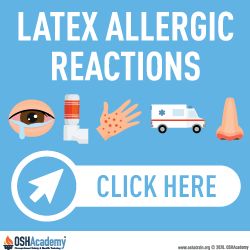Latex Allergy Prevention
Latex Definition
According to Webster's Dictionary, the term 'latex' refers to natural rubber latex (NRL), a product manufactured from the milky fluid derived from the rubber tree, Hevea brasiliensis.
Several types of synthetic rubber are also referred to as "latex," but these do not release the proteins that cause allergic reactions.
Latex Allergies
Latex allergy was first recognized in the late 1970s. Since then, it has become a major health concern as an increased number of people in the workplace are affected. Health care workers, especially those exposed to latex gloves or medical products containing latex, are at significant risk. An estimated 8-12% of health care workers are sensitive to latex.
Workers in the health care industry (physicians, nurses, dentists, technicians, etc.) are at risk for developing a latex allergy because they use latex gloves frequently. Workers with less frequent glove use (hairdressers, housekeepers, food service workers, etc.) and workers in industries that manufacture latex products are also at-risk for having a latex allergy.
Workers who are exposed to latex gloves and other products that contain natural rubber latex may develop some of the following allergic reactions:
- skin rashes (such as hives)
- nasal, eye, or sinus symptoms (sneezing, itchy eyes, or wheezing from exposure to airborne latex particles)
- asthma
- shock (rarely)
Knowledge Check Choose the best answer for the question.
1-1. Which of the following is considered an allergic reaction to latex?
You forgot to answer the question!

